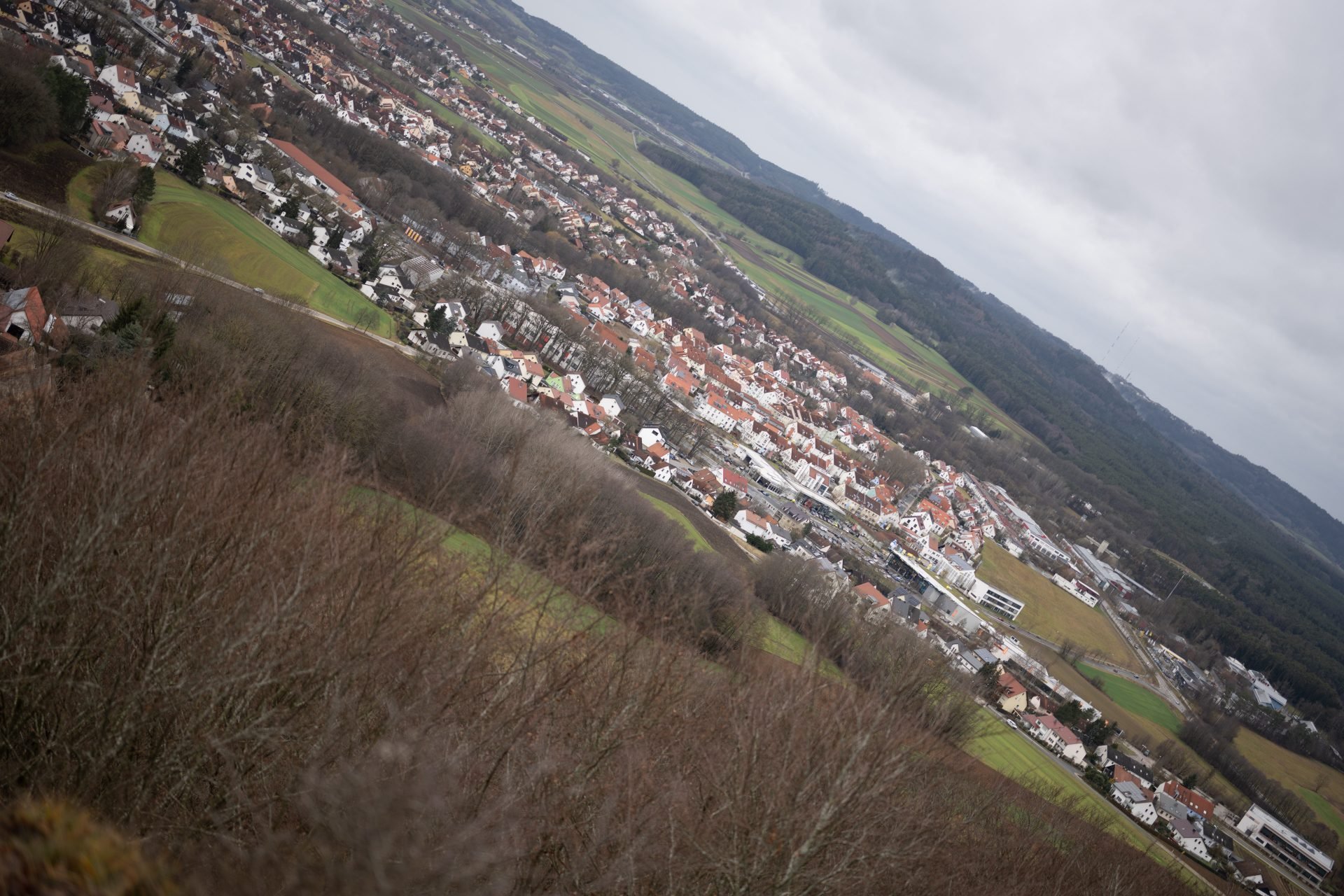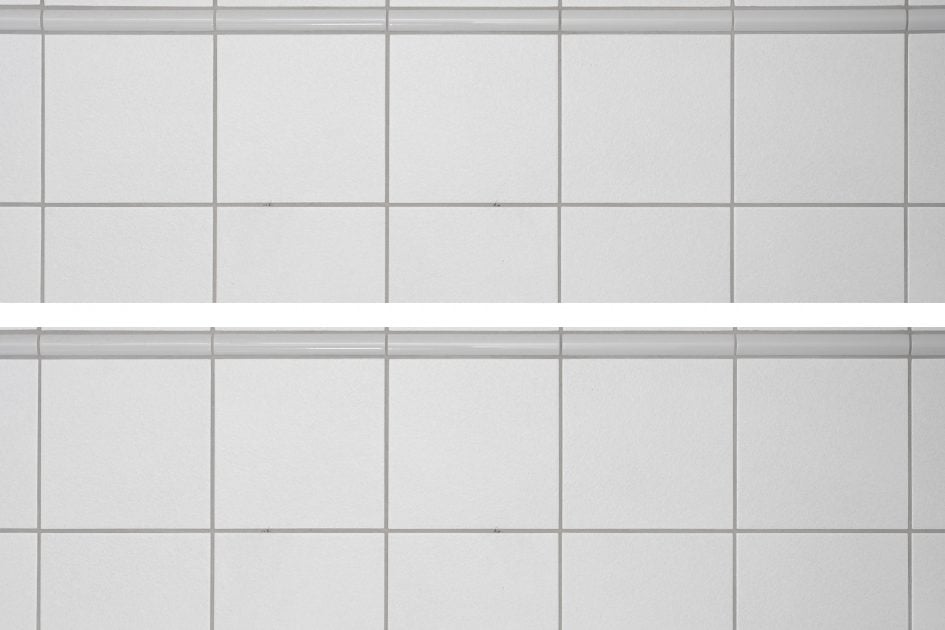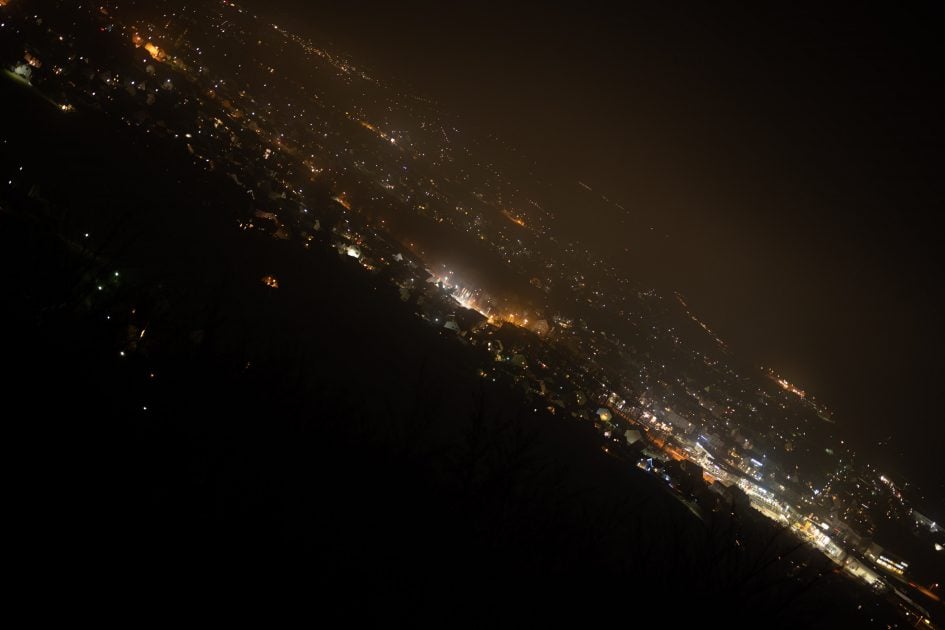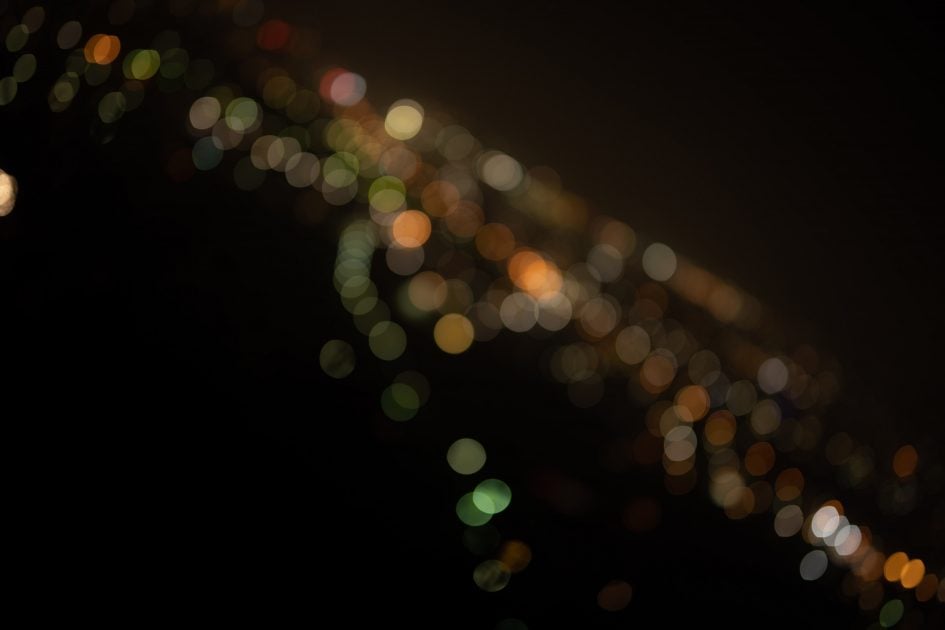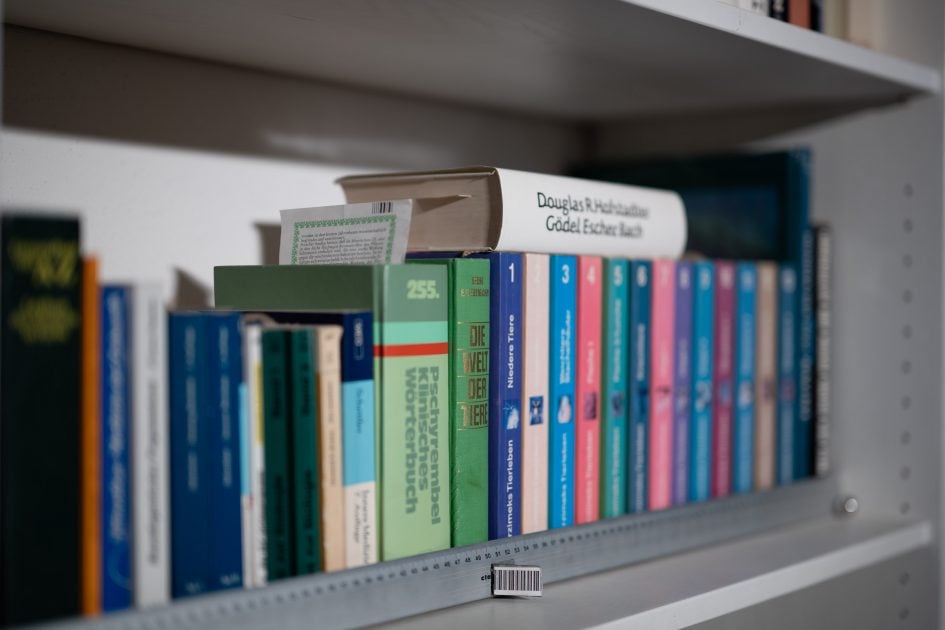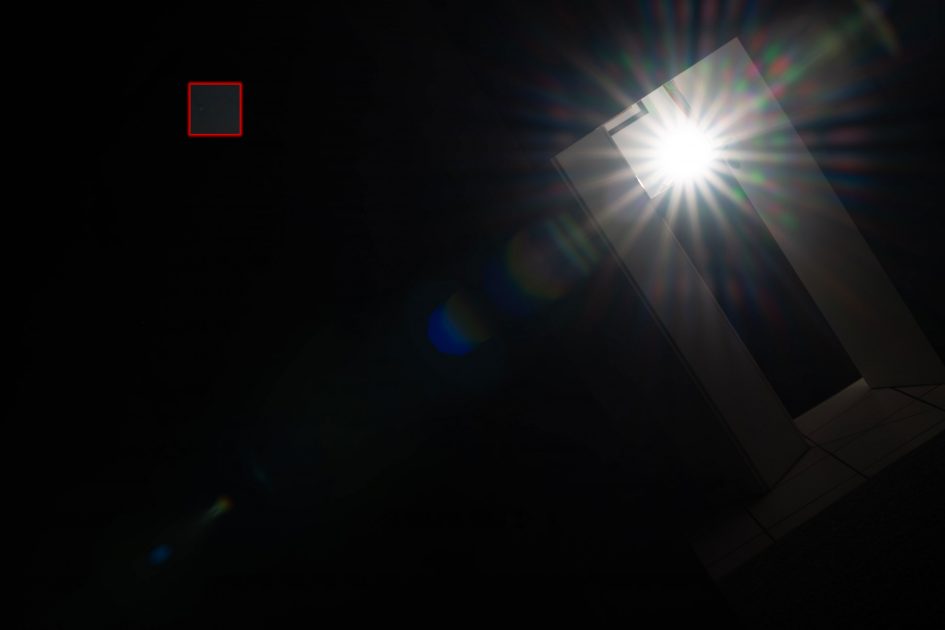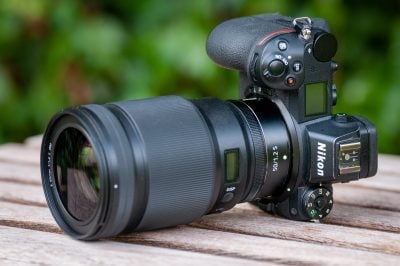Nikon Z 50mm f1.2 S review
-
-
Written by Thomas
Quality
Testing: Longitudinal Chromatic Aberration and focus shift
Lenses with focal ratios of f2.8 or larger are often prone to longitudinal color aberrations (loCA, a.k.a. “axial color” or “bokeh CA”). These show up as magenta coloration in the foreground and greenish hues in the background and are not easily corrected in post-processing. LoCA of the Z 50mm f1.2 S is comparable to the Nikon Z 50mm f1.8 S and a bit better than from the Z Noct:
Nikon Z 50mm f1.2 S Longitudinal Chromatic Aberration (loCA)
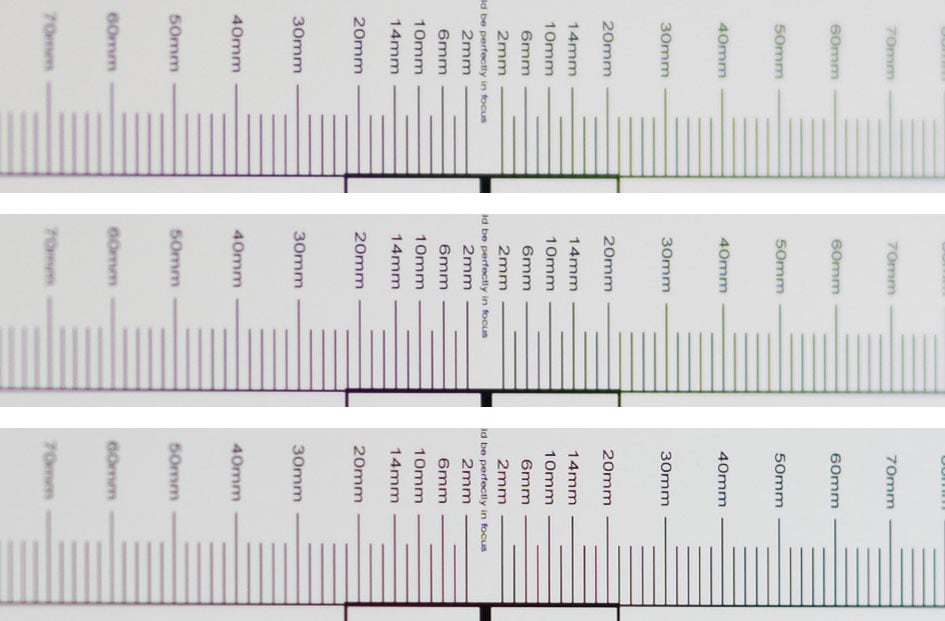
100% crops, from top to bottom: f1.2, f1.4, f2.0; left = foreground, right = background
The test also revealed that there is a tiny bit of focus shift at distances of 2m and farther away and the background sharpens up much faster than the foreground when the lens is stopped down. For comparison have a look at the Nikon Z 58mm f0.95 S Noct (at f0.95/f1.4/f2.0), Nikon 58mm f1.4G (at f1.4/f2.0/f2.8), and the Nikon Z 50mm f1.8 S (f1.8/f2.0/f2.8).
The following real life shot shows that the Z 50mm f1.2 S produces some purple fringing around high-contrast edges in the focal plane and green outlining around background subjects:
Above: Nikon Z 50mm f1.2 S at f1.2; 100% crop; click image for 4k version, here for large original
Sharpness and contrast
Let’s have a look at the theoretical performance of the new Nikon Z 50mm f1.2 S and compare it to the performance of the Nikon Z 58mm f0.95 S Noct, Nikon Z 50mm f1.8 S, and Nikon AF-S 58mm f1.4G:
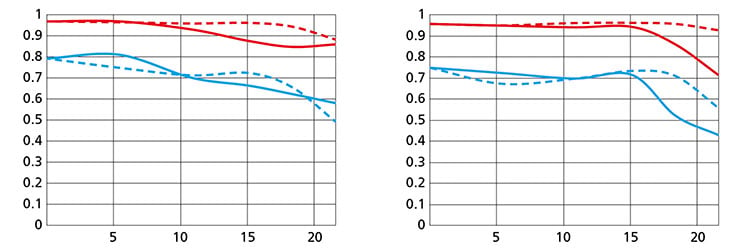
Above: Nikon Z 50mm f1.2 S at f1.2 (left), Z 58mm f0.95 S Noct at f0.95 (right)
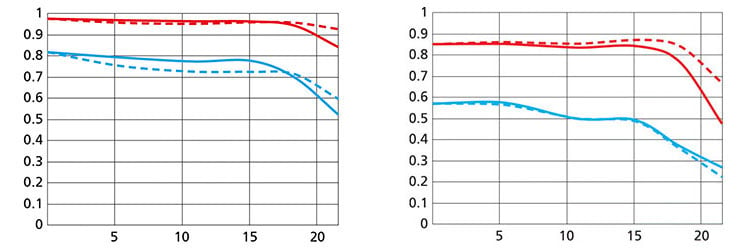
Above: Nikon Z 50mm f1.8 S at f1.8 (left), Nikon AF-S 58mm f1.4G at f1.4 (right)
These MTF charts of the Nikon lenses show the computed lens-performance wide open without influence of diffraction at 10 line-pairs/mm (in red) and 30 lp/mm (in blue). Higher values are better (more contrast) and the closer the dotted and solid lines are together the less astigmatism (= resolution depends on the orientation of the test-pattern) the lens has. The x-axis displays the distance from the optical axis (=center of the sensor) in mm. I’ll show you the real-life performance at 4 mm (center), 13 mm (DX-corner), and 20 mm (FX-corner) on a 45MP Nikon Z7 body.
From the charts the new Nikon Z 50mm f1.2 S shows less drop-off in sharpness and contrast in the FX-corner than the other three lenses. But there is a slight dip in sharpness at 10mm image height and some astigmatism or field-curvature at and beyond the DX-corner. And one thing is clear: the new Z-Nikkors all outperform the older F-Nikkor 58mm f1.4G – even wide(r) open.
Let’s see how this theoretical performance of Nikon’s new Z-Nikkor translates into real life results in the sharpness test based on Siemens-stars. Processing was done in Lightroom 10.1/CRAW 13.1 from RAW to Adobe Color profile Adobe Color profile with the built-in lens profile compensating CA, distortions, and vignetting. Diffraction compensation was OFF. Noise-reduction is set to 0, sharpening to 50/0.5/36/10, with no extra tone, color, or saturation adjustment. White-balance was adjusted to a neutral white and I did some exposure compensation to make the brightness of all crops match. So you will not see light fall-off in the corners.
The following 100% crops show the Nikon Z 50mm f1.2 S from f1.2 down to f11 compared to the Nikon Z 58mm f0.95 S Noct, Nikon 58mm f1.4G (on FTZ adapter), and Nikon Z 50mm f1.8 S.
Nikon Z 50mm f1.2 S compared; 100% crop from center, DX-corner, FX-corner

Above: Nikon Z 50mm f1.2 S at f1.2

Above: Nikon Z 58mm f0.95 S Noct at f1.2; also available at f0.95, f1.4, f1.8, f2.0, f2.8, f4.0, f5.6, f8.0, f11
At f1.2 the Z Noct is clearly sharper across the sensor than the Z 50mm f1.2 S. But the Z Noct also shows a bit of coloration.
At f1.4 the Nikon 58mm f1.4G enters the competition but clearly is no match for both Z Nikkors:

Above: Nikon Z 50mm f1.2 S at f1.4

Above: Nikon Z 58mm f0.95 S Noct at f1.4

Above: Nikon 58mm f1.4G at f1.4; also available at f1.8, f2.0, f2.8, f4.0, f5.6, f8.0, f11
F1.8 brings the Nikon Z 50mm f1.8 S into the comparison:

Above: Nikon Z 50mm f1.2 S at f1.8

Above: Nikon Z 58mm f0.95 S Noct at f1.8

Above: Nikon Z 50mm f1.8 S at f1.8; also available at f2.0, f2.8, f4.0, f5.6, f8.0, f11

Above: Nikon 58mm f1.4G at f1.8
At f1.8 the Nikon Z 50mm f1.2 S is of comparable sharpness to the Z 50mm f1.8 S and still slightly behind the Z Noct. Nikon’s 58mm f1.4G still clearly is the least sharp of the four lenses.
Stopping the Z 50mm f1.2 further down shows that from f2.8 onwards the lens produces a very good FX corner:

Above: Nikon Z 50mm f1.2 S at f2.0

Above: Nikon Z 50mm f1.2 S at f2.8

Above: Nikon Z 50mm f1.2 S at f4.0

Above: Nikon Z 50mm f1.2 S at f5.6; also available at f8.0, f11
Overall Nikon’s new Z 50mm f1.2 S lens is a clear improvement over their DSLR designs and matches the very good performance of the Z 50mm f1.8 S. The test also revealed a little field curvature.
Performance at long distances
The Siemens-star test-targets are shot at a distance of 45x focal length (i.e. at around 2.3m for 50mm focal length). But performance of lenses also depends on the shooting distance. Therefore I present another series of test-shots of a city around 1 km away. Processing was done in Lightroom 10.1/CRAW 13.1 from RAW to Adobe Color profile with the built-in lens profile compensating CA, distortions, and vignetting. Diffraction compensation was OFF. Noise-reduction is set to 0, sharpening to 50/0.5/36/10, with no extra tone, color, or saturation adjustment. To compensate for any focus-shift I used autofocus at each aperture. All shots were made at ISO 64 and image stabilization switched off
During the period of testing atmospheric conditions were far from ideal. I chose a day with good visibility but the overcast sky means that the contrast of the scene is not as high as usual. For comparison have a look at the long distance shots with the Nikon Z 50mm f1.8 S and Nikon Z 58mm f0.95 S Noct.
The main image shows the complete scene wide open to give you an impression of the angle of view and to judge vignetting. Following the main image are 100% crops from the center, DX-corner, and FX-corner for the Nikon Z 50mm f1.2 S at different apertures.
You can access the large original but please respect our copyright and only use those images for personal use.
Above: Nikon Z 50mm f1.2 S at f1.2
Above: Nikon Z 50mm f1.2 S at f1.2; 100% crops, click image for 4k version, here for large original

Above: Nikon Z 50mm f1.2 S at f1.4

Above: Nikon Z 50mm f1.2 S at f1.8

Above: Nikon Z 50mm f1.2 S at f2.0

Above: Nikon Z 50mm f1.2 S at f2.8

Above: Nikon Z 50mm f1.2 S at f4.0; also available at f5.6, f8.0
The long-distance test confirms that the Nikon Z 50mm f1.2 S produces images that are sharp across the sensor even at f1.2. Stopping down to f1.4 gives sharpness a slight boost. The FX-corner stays a bit behind due to field-curvature – even stopped down to f4.0: if I had focused in the corner it would have come out visibly sharper.
Vignetting and distortions
To make it easier to see light fall-off in the corners of a full-frame sensor I’ve arranged a series of three shots each with the new Z-Nikkor from f1.2 to f2.0. All images were developed to the same brightness in the center and are shown with vignette control Off (1st row) resp. Normal (2nd row):
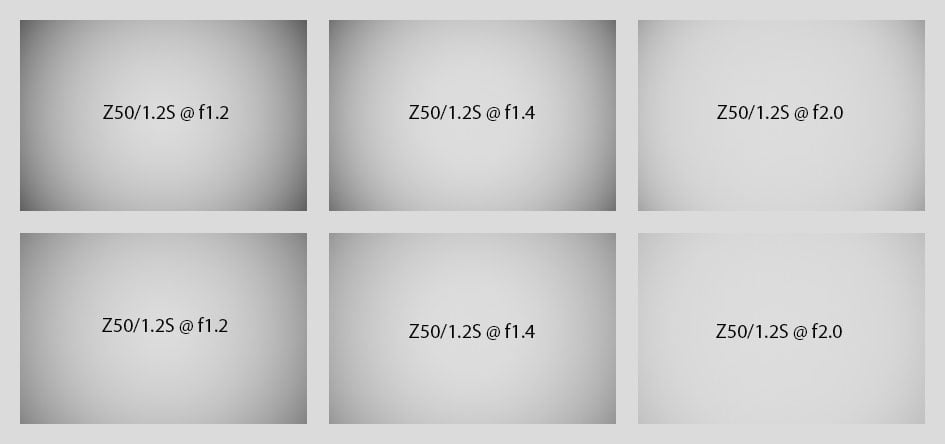
Above: Nikon Z 50mm f1.2 S at f1.2, f1.4, f2.0
The sample images above show that with the lens profile applied vignetting is OK at f1.2 and f1.4. From f2.0 there is nothing to worry about. At f1.2 automatic shading compensation lifts the extreme corners about 0.5-0.6 EV which is pretty moderate. I didn’t test Vignette control at “high” which should give the corners a stronger lift. Adobe’s RAW converter automatically applies Vignette control as it was set in camera – but you cannot alter the setting in postprocessing.
That’s different with distortions: Adobe’s RAW converter ignores what was set in camera and always corrects them. So I had to do the following comparison with JPGs straight out of camera. Distortions are very low even without lens profile:
Distortions: Nikon Z 50mm f1.2 S, as is (top) / with lens-profile (bottom)
Rendering of point-light sources at night-shots
Night-shots pose a different challenge for lenses as the contrast is even higher than under bright sun and point-light sources can reveal some weaknesses such as coma, haloing and colour-aberrations that do not show up as prominently in other test-shots. The 100% crops below the main image show the effect of coma in the FX-corner of the Nikon Z 50mm f1.2 S at various apertures:
Above: Nikon Z 50mm f1.2 S at f1.2; click image for 4k version, here for large original

Above: Nikon Z 50mm f1.2 S; 100% crops from the FX-corner at f1.2 (left), f1.4 (middle), f2.0 (right)
The new Nikon Z 50mm f1.2 S is not free of coma but it is certainly well controlled. By f2.0 it is gone.
Bokeh quality
This test is for the rendering of point-light sources in an out-of-focus background. The circle of confusion that is produced by this test is pretty indicative of Bokeh performance in the background. Ideally the out-of-focus image of the point-light is evenly lit and perfectly circular, with no “onion-rings”, and without coloration. Large aperture lenses normally produce an effect known as “cat’s eye” the further away from the optical axis the point-light is projected. This is due to optical vignetting in the lens barrel when light enters the lens from an angle.
The following crops at different apertures are from near the center, DX-corner, and FX-corner resized to make them comparable across all my reviews.
Above: Nikon Z 50mm f1.2 S at f1.2; click image for 4k version

Above: Nikon Z 50mm f1.2 S at f1.2

Above: Nikon Z 50mm f1.2 S at f1.4

Above: Nikon Z 50mm f1.2 S at f2.0

Above: Nikon Z 50mm f1.2 S at f2.8
The diameter of the Bokeh balls in the center is determined by the entrance pupil of the lens. So at their respective largest aperture the Nikon Z 50mm f1.2 S has 30% smaller Bokeh balls than the Z 58mm f0.95 S Noct but 50% bigger ones than the Z 50mm f1.8 S. Onion rings or texture within the Bokeh balls of the Nikon Z 50mm f1.2 S are almost a non-issue. Outlining may be more of a distractor but it is relatively mild with only a slight green coloration to it. Cat’s eyes towards the corners are pretty prominent but mostly gone at f2.0. But the edges of the aperture blades can clearly be seen from f2.8 onwards.
Now let’s see how this analysis of out-of-focus point-light sources translates into Bokeh-performance shooting a book-shelf. Crops are from the foreground, middle-ground, and background resized to make them comparable across all my reviews.
Above: Nikon Z 50mm f1.2 S at f1.2
Above: Nikon Z 50mm f1.2 S at f1.2; click image for 4k version, also available as large original at f1.2, f1.8

Above: Nikon Z 50mm f1.8 S at f1.8; click image for 4k version, also available as large original at f1.8, f2.0, f2.8, f4.0, f5.6

Above: Nikon Z 58mm f0.95 S Noct at f0.95; click image for 4k version, also available as large original at f0.95, f1.2, f1.4, f1.8, f2.0, f2.8, f4.0, f5.6

Above: Nikon 58mm f1.4G at f1.4; click image for 4k version, also available as large original at f1.4, f1.8, f2.0, f2.8, f4.0, f5.6
Wide open the Bokeh of the Z 50mm f1.2 S is second only to the Z Noct and clearly better than from the Z 50mm f1.8 S or the Nikon 58mm f1.4G. But stop down to f1.8 and the Bokeh of the Z 50mm f1.2 S and Z 50mm f1.8 S are almost indistinguishable.
Looking at another crop (now at 100%) from the same image showing the ruler reveals a slight tendency for double contours of the Z 50mm f1.2 S. And that the Nikon 58mm f1.4G produces a completely different style of blur behind the plane of sharpest focus.

Above: Nikon Z 50mm f1.2 S at f1.2; click image for 4k version, here for large original

Above: Nikon Z 50mm f1.8 S at f1.8; click image for 4k version, here for large original

Above: Nikon Z 58mm f0.95 S Noct at f0.95; click image for 4k version, here for large original
Above: Nikon 58mm f1.4G at f1.4; click image for 4k version, also available as large original at f1.4, f1.8, f2.0, f2.8, f4.0, f5.6
If you’re curious how this all shapes up when shooting portraiture have a look at the samples section on the next page.
Close-up performance
The Z 50mm f1.2 S goes down to 1:6.1 magnification which is not much. And image quality is clearly softer than at normal distances. The following image was shot at the maximum magnification of 1:6.1 where the area of sharp focus is 220 x 147mm. The 100% crops shown below are from the center, 11mm, and 18mm off the center of the sensor respectively:

Above: Nikon Z 50mm f1.2 S at f1.2, 1:6.1 magnification

Above: Nikon Z 50mm f1.2 S at f2.0, 1:6.1 magnification

Above: Nikon Z 50mm f1.2 S at f4.0, 1:6.1 magnification

Above: Nikon Z 50mm f1.2 S at f8.0, 1:6.1 magnification
Stopping down to f4 produces a pretty sharp DX image-circle but for better corner sharpness you need to stop down to f8.0 or beyond. This is comparable to what the Z 50mm f1.8 S can do. The Z Noct is clearly better in this respect.
Flare, glare, ghosting, and sun-stars
Catching a strong light-source shining directly into the lens is always a risky business: it could produce strange colorful ghost-images or reduce contrast considerably through flare and glare. The appearance of flare and ghosting depends on factors like the aperture and the angle of the light hitting the lens. So to judge the proclivity of the new Nikon Z 50mm f1.2 S for these artifacts I went through a series of well calculated shots against a strong light source to provoke glare and ghosting. The lens hood was mounted in all shots. Following is one of the more extreme example results. The little bright square inset in the upper left shows the respective area with an exposure compensation of +3 EV to make it easier to see which levels of black the lens renders at that point:
Above: Flare and ghosting. Strong light hitting the Nikon Z 50mm f1.2 S at f11; click image for 4k version or here for +3 EV exposure compensation
Flare and glare is pretty well controlled and the lens shows only muted ghosts from the aperture at f11. Outside these artifacts the lens produces a very deep black. For comparison have a look at the Nikon Z 58mm f0.95 S Noct, Nikon Z 50mm f1.8 S, or Nikon 58mm f1.4G, all shown at f11. The lens also produce only a mild flare when the light-source is just outside the corner.
All-in-all the Nikon Z 50mm f1.2 S let’s you shoot confidently under adverse contra-light situations which is quite a feat for a complex lens construction with 30 glass/air surfaces. I assume the combination of Nano- and ARNEO-coating is doing the trick here. The Nikon Z 50mm f1.2 S produces nice sunstars at f5.6 already:

Above: Sunstars from the Nikon Z 50mm f1.2 S at f5.6 (left) and f8.0 (right), 100% crops
Next check out my sample images!
Check prices on the Nikon Z 50mm f1.2 S at B&H, Adorama, WEX or Calumet.de. Alternatively get yourself a copy of my In Camera book or treat me to a coffee! Thanks!
